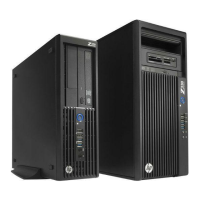●
Use static-dissipative mats, foot straps,
or air ionizers to give added protection.
●
Handle electrostatic-sensitive
components, parts, and assemblies by
the case or PCB laminate. Handle them
only in static-free work areas.
●
Use fixtures made of static-safe materials
when fixtures must directly contact
dissipative surfaces.
●
Keep work area free of conductive
materials, such as plastic assembly aids
and Styrofoam.
●
Use field service tools (such as cutters,
screwdrivers, and vacuums) that are non-
conductive.
Recommended ESD
prevention materials
and equipment
●
Antistatic tape
●
Antistatic smocks, aprons, and sleeve
protectors
●
Non-conductive bins and other assembly
or soldering aids
●
Non-conductive foam
●
Non-conductive tabletop computers with
a ground cord of one megohm ± 10%
resistance
●
Static-dissipative table or floor mats with
a hard-tie to ground
●
Field service kits
●
Static awareness labels
●
Wrist straps and footwear straps providing
one megohm ± 10% resistance
●
Material-handling packages
●
Non-conductive plastic bags
●
Non-conductive plastic tubes
●
Non-conductive tote boxes
●
Opaque shielding bags
●
Transparent metallized shielding bags
●
Transparent shielding tubes
56 Chapter 3 Component replacement information and guidelines

